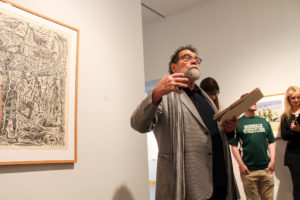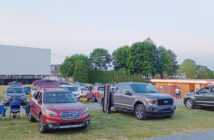Every semester, the Lehigh University Art Galleries rotate their exhibits, some of which have been in the works for several years.
Professor Ricardo Viera, the director and chief curator, was able to bring the private Cuban collection, “Drawings of Wifredo Lam,” to Lehigh. The process of bringing the exhibit to Zoellner Arts Center took 20 years.
LUAG is a network of academic teaching museums across campus that reaches both the Lehigh and Bethlehem communities. Museum educator Patricia McAndrew said she noticed more and more students have been visiting the galleries and educating themselves about art.
Mark Wonsidler, a curatorial associate for exhibitions and collections, said the curated exhibitions often connect to classes and academics on campus.
“We try to bring a diverse range of ideas and practices to campus from the outside world,” Wonsidler said, “but also to expose the range of practices and ideas embodied in our own collection. We have a permanent collection of over 15,000 objects that we are constantly rotating through exhibitions and galleries to bring them to the eyes of students and faculty and researchers and others who may be interested in them.”

Professor Ricardo Viera, the director and chief curator of LUAG, discusses a piece during the gallery talk on Thursday, April 21, 2016. Viera helped to bring a diverse selection of exhibitions to Lehigh this year. (Meg Kelly/B&W Staff)
McAndrew said the pieces exhibited could be chosen two or three years in advance, depending on the exhibition requirements. She said the amount of space and configuration of the gallery had to be taken into account.
In addition, McAndrew said curating art requires a good eye and a passion for the arts. Viera needs to balance his own personal interests and vision with the configurations of the gallery and what pieces would be most suitable for the show.
“We have rented art shows when we had Judy Chicago’s ‘Holocaust Project’ and the Charles Schulz (exhibit) about Snoopy and the ‘Peanuts’ characters, which was one of the most popular shows we’ve ever had,” McAndrew said. “We had the show last semester ‘Bartram’s Boxes Remix’ from the Center for Art in Wood in Philadelphia.”
The photography show by Aaron Siskind in Maginnes Hall was donated by a Lehigh alumnus. She said other works were purchased through funds or entrusted to LUAG by students, parents, alumni or friends of the arts.
The head proprietor of the curatorial team, Jeffrey Ludwig-Dicus, is responsible for the layout, colors and lighting of the show after the pieces are selected.
Ludwig-Dicus said for the María Martínez-Cañas photography show in Zoellner’s main gallery, he experimented with pieces of different sizes and periods of time.
“I try to swap older things next to newer things, sort of try to make a dialogue between the images,” Ludwig-Dicus said. “We try to fit the feeling of the way that the show appears to the work, so that means reconfiguring the gallery, building walls, changing the pathway. It helps us to kind of guide the unfolding of the exhibition.”
Lights in the Zoellner gallery change the wall color for each exhibit. Ludwig-Dicus said the curatorial team has turned the gallery into a 17th century Spanish salon drawing room, a 1980s pop concert and a 1960s lounge with “chrome furniture and pleather-plastic looking stuff.”
Ludwig-Dicus said when curating the hallway gallery “Visionaries of the Light” at Rauch Business Center, he focused more on the placement of the show because the colors of the walls could not be changed. He said by making the exhibition more dense by placing pieces closer together or having a cluster next to single works, it changed the pace for people walking through the gallery.
The exhibition in Siegel Gallery at Iacocca Hall, “Estraño: Stranger Things,” included art from various artists who emphasized the strangeness and fascination of everyday objects. Wonsidler said the refurbished building added more space for larger, oversized pieces.
“All the exhibitions that we do here, they’re organized and thought through at least somewhere in the neighborhood of two years,” Ludwig-Dicus said. “So we start with the basic information that we have about the work. We call it our ‘tombstone’ information — it’s basically a title, a date, the artist, medium. We figure out what the sizing of everything is going to be. I make digital scale models of everything using photographs.”
The main gallery at Zoellner, Dubois Gallery in Maginnes and the gallery at Rauch rotate every semester. McAndrew said the lower gallery in Zoellner changes about every two years from Lehigh’s permanent teaching collection.





Comment policy
Comments posted to The Brown and White website are reviewed by a moderator before being approved. Incendiary speech or harassing language, including comments targeted at individuals, may be deemed unacceptable and not published. Spam and other soliciting will also be declined.
The Brown and White also reserves the right to not publish entirely anonymous comments.